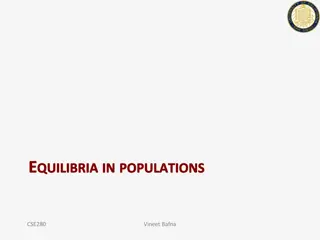Understanding General Equilibrium Models and Social Accounting Matrices
General Equilibrium Models (CGE) and Social Accounting Matrices (SAM) provide a comprehensive framework for analyzing economies and policies. This analysis delves into how CGE models help simulate various economic scenarios and their link to SAM, which serves as a key data input for the models. The interplay between different agents like households, government, and markets is described, along with the mathematical representation of CGE models and the structure of SAM.
Download Presentation

Please find below an Image/Link to download the presentation.
The content on the website is provided AS IS for your information and personal use only. It may not be sold, licensed, or shared on other websites without obtaining consent from the author. Download presentation by click this link. If you encounter any issues during the download, it is possible that the publisher has removed the file from their server.
E N D
Presentation Transcript
A General Equilibrium Analysis of Time Use and Unpaid Domestic and Care Work: GEM-Care and Illustrative Application to Colombia: Mart n Cicowiez (CEDLAS-UNLP) Presentation at Workshop G nero y Econom a , Pontificia Universidad Javeriana, Villa de Leyva, Colombia, Septiembre 26-28, 2019
Contents Computable General Equilibrium (CGE) and Social Accounting Matrix: A Primer GEM-Care: A Gendered CGE Model for the Analysis of Care and data needs = gendered SAM Illustrative Application of GEM-Care to Colombia
What is a CGE model? A CGE model is the computer representation of a real economy; links between (multiple) productive sectors, factors, households, government, and BoP Mathematically, a CGE model is a system of simultaneous non-linear equations. Types of equations: behavioral (e.g., profit maximizing producers) balance/equilibrium (e.g., savings = investment) definitions (e.g., household income)
Flow of Payments (Single Period) domestic wages and rents hhd net savings Factor Markets Households direct taxes financing transfers private consumption factor demand Non-Gov Capital Account transfers indirect taxes foreign wages and rents Government gov cons and inv interm input dem financing transfers financing Activities Commodity Markets Rest of World imports dom demand exports non-gov investment
What is a CGE Model? cont. In general, models have a common core and details depend on context. For each agent, explicit decision rules, subject to budget and resource constraints, acting in markets. SAM (Social Accounting Matrix) is the major data source. Typically, used for ex-ante simulation analysis in a wide range of policy areas trade, taxation, sector, poverty/inequality, natural resources and environment, labor, demography
What is a SAM? A SAM is a comprehensive, economy-wide data framework a square matrix with identical row and column accounts where each cell shows payment (at current prices) from its column account to its row account used for descriptive purposes and as the key data input for CGE models (which explain SAM payments)
Definitions: GDP and Non-GDP Sectors GDP (or SNA) = market non-market production, typically by government home production for home consumption of goods, also non-market e.g., production of food for self-consumption Non-GDP (or non-SNA) = home production for home consumption of services, also non-market e.g., unpaid domestic and care work
Standard (GDP) Macro SAM Colombia 2015 (GDP%) a-repr-gdp 168.3 c-repr-gdp tax-indir f-lab-m sav-inv 168.3 tax-dir f-lab-f a-oth c-oth f-cap total hhd row gov a-oth a-repr-gdp c-oth c-repr-gdp f-lab-f f-lab-m f-cap tax-indir tax-dir hhd gov row sav-inv total 0.7 0.7 77.7 62.4 0.7 18.3 15.2 26.7 200.3 0.7 19.4 37.2 33.1 10.7 7.4 98.5 27.6 26.3 26.7 18.6 36.9 33.1 2.0 0.7 0.1 0.2 0.3 8.7 7.4 19.4 37.2 32.1 1.0 8.4 1.4 0.6 10.7 7.4 8.0 2.9 17.2 98.5 23.4 0.0 0.0 0.9 27.6 8.6 26.3 168.3 0.7 200.3 0.7 19.4 37.2 33.1 10.7 7.4 26.7
Notation in SAM Account a-oth a-repr-gdp c-oth c-repr-gdp f-lab-f f-lab-m f-cap tax-indir tax-dir hhd gov row sav-inv Descrption activities - all other activities - reproductive/care GDP commodities - all other commodities - reproductive/care GDP labor - female labor - male capital tax - indirect tax - direct institutions - households institutions - government institutions - rest of the world institutions - savings-investment
Why Develop a (Gendered) CGE Model for the Analysis of Care? It can capture -- if appropriately structured and disaggregated roles of different sources of care services (households, private sector, government) links between care sectors, gendered time use, and gendered labor market effects of government policies role of care in development of the modeled economy
Literature Review In CGE literature, degree of gender-awareness varies: only labor market, +unpaid domestic and care work, +leisure Fontana and Wood 2000; Fontana 2004, Fofana et al. 2005; Cockburn et al. 2007, Mitik and Decaluw 2009, Fontana 2013, Severini et al. 2018 most papers focus on gender impact trade liberalization also relevant, literature related to home production and tax policies: Ferri et al. 2005, Whalley and Zhao 2013
GEM-Care It started from GEM-Core: a simpler country CGE model coded in GAMS (Cicowiez and Lofgren 2017) that may be used in comparative-static or dynamic-recursive modes with or without Excel-based interface (appropriate for training) It is being developed, drawing on features in MAMS (Lofgren et al. 2013) and the gendered CGE literature AU project; template model that is relevant to gender analysis across different country types
GEM-Care cont. It shares features with Fontana and Wood (2000): activities and commodities cover both GDP and non-GDP (or household) production, the latter including leisure and household service production for own consumption time use (a production input) is gendered and split into discretionary (endogenous) non-discretionary (exogenous; time satisfying basic needs like sleep, hygiene)
GEM-Care cont. Also, services produced by the household and the GDP (private/government) are imperfect substitutes in household demand, using a nested structure wage discrimination la Becker (a first for CGE models): part of male-female wage gap attributed to discrimination against females (= wage setting based on underestimate of the marginal productivities of women relative to men) Following GEM-Core and MAMS, expanded treatment of government (policy tools, including care subsidies; sources of revenue and financing).
Production Function Activity Output Leontief Intermediate Inputs Value Added CES Capital Labor CES Labor-F Labor-M
Utility Function Utility Level LES Leisure Female Leisure Male Other Cons Care CES Care Non- GDP Care GDP Note: unpaid care and leisure produced using own labor; relevant with multiple households.
(this section is inspired by Lpez et al. 2015) AN ILLUSTRATIVE APPLICATION TO COLOMBIA
Definition of Domestic and Care Work or Reproductive Sector It comprises housework such as meal preparation, shopping, laundry, and cleaning direct care of persons It can be paid (i.e., provided by the market or government) or unpaid if unpaid (i.e., consumed within the same household), it is outside the SNA
Motivation: work within and outside the SNA by gender; Colombia 2015 Total hours worked Average hours worked per week 60,000 80 70 50,000 60 hours per week 40,000 million hours 50 30,000 40 30 20,000 20 10,000 10 0 0 total within NA outside NA total within NA outside NA male female male female QUESTION: what would be the impact of increased public financing of care services? (e.g., child and elderly care services).
Method: GEM-Care Again, two level VA production function: imperfect substitution between male and female labor two-level utility function: imperfect substitution between GDP and non-GDP domestic and care services endogenous allocation of discretionary time: market, social reproduction, and leisure modeling of leisure and unpaid domestic and care work: consumption of household-specific commodities produced using own male and female labor formal and informal segments in labor market not fully included travel time modeled as iceberg cost not included
Data: Extended SAM Colombia 2015 Two main (non-standard) data sources: 2012-2013 National Survey on Time Use (ENUT) 2015 Satellite Account on the Economy of Care both data sources required by Law 1413 from 2010 Besides, had to value unpaid domestic and care work: replacement cost leisure time: average market wage, by gender SAM dimensions: 16 activities and commodities including paid and unpaid domestic and care services, and leisure by gender 6 factors (lab-f, lab-m, cap, land, ext, natres) 4 institutions (households, enterprise, gov, RoW)
Non-SNA Sectors in SAM Unpaid Domestic and Care Work unpaid domestic services for household and family members unpaid caregiving services for household and family members Leisure culture, leisure, mass-media, and sports practices excludes personal care (e.g., sleeping) SAM excludes time devoted to self-care and maintenance.
Gendered (GDP+Non-GDP) Macro SAM Colombia 2015 (GDP%) a-repr-ngdp c-repr-ngdp a-leisure-m 168.3 c-leisure-m a-repr-gdp c-repr-gdp a-leisure-f c-leisure-f tax-indir f-lab-m sav-inv tax-dir f-lab-f a-oth c-oth f-cap total hhd row gov a-oth a-repr-gdp a-repr-ngdp a-leisure-f a-leisure-m c-oth c-repr-gdp c-repr-ngdp c-leisure-f c-leisure-m f-lab-f f-lab-m f-cap tax-indir tax-dir hhd gov row sav-inv total 168.3 0.7 18.2 24.5 30.7 0.7 18.2 24.5 30.7 77.7 62.4 0.7 18.2 24.5 30.7 18.3 15.2 26.7 200.3 0.7 18.2 24.5 30.7 57.5 72.6 33.1 10.7 7.4 171.9 27.6 26.3 26.7 18.6 36.9 33.1 2.0 0.7 0.1 13.6 4.7 24.5 0.2 0.3 30.7 8.7 7.4 57.5 72.6 32.1 1.0 8.4 1.4 0.6 10.7 7.4 8.0 2.9 17.2 23.4 0.0 0.0 0.9 27.6 8.6 26.3 168.3 0.7 18.2 24.5 30.7 200.3 0.7 18.2 24.5 30.7 57.5 72.6 33.1 10.7 7.4 171.9 26.7
Notation in SAM Account a-oth a-repr-gdp a-repr-ngdp activities - reproductive/care non-GDP a-leisure-f activities - leisure - female a-leisure-m activities - leisure - male c-oth commodities - all other c-repr-gdp commodities - reproductive/care GDP c-repr-ngdp commodities - reproductive/care non-GDP c-leisure-f commodities - leisure - female c-leisure-m commodities - leisure - male f-lab-f labor - female f-lab-m labor - male f-cap capital tax-indir tax - indirect tax-dir tax - direct hhd institutions - households gov institutions - government row institutions - rest of the world sav-inv institutions - savings-investment Descrption activities - all other activities - reproductive/care GDP
Sectoral Value Added SNA and Non- (trillion pesos) 0 200 400 600 800 1000 agr SNA min mnfc other ind svc reprod-gdp SNA+Non-SNA reprod-ngdp Source: GEM-Care Colombia 2015 Dataset.
Gender Composition of Labor Demand by Activity (%) 100% 90% 80% 70% 60% 50% 40% 30% 20% 10% 0% Female Male Source: GEM-Care Colombia 2015 Dataset.
Time Use by Gender (%) Female Male mnfc other ind min agr min agr mnfc other ind svc leisure leisure reprod- gdp svc reprod- ngdp reprod- ngdp reprod- gdp Source: GEM-Care Colombia 2015 Dataset.
Central Elasticities Top Nest VA agr: 0.25 min: 0.2 other: 0.95 Bottom Nest VA -- substitution male/female -- values reflect rigidity in gender roles GDP: 0.5 reproduction: 0.25 leisure: by gender no substitution Price Elasticities in LES agr: -0.85 reproduction: -0.5 leisure: -0.85 other: -1 GDP/Non-GDP reproduction: 1.5 Armington and CET agr and min: 2 mnfc: 1.5 other indust and svc: 0.8
Macro Closure and Factor Markets To assess impact on welfare using static model, Current Account BoP: flexible exchange rate Government Budget: flexible direct tax rate Savings-Investment: flexible marginal propensity to save Factor Markets labor: perfectly mobile capital and natural resources: sector-specific
Scenarios sub: government subsidizes households consumption of market domestic and care work (25%) pweagr: 50% increase in world export price of agriculture products 10.4% total SNA employment infor: reduction of informality rate for paid domestic workers tax on factor use (20%; =avg) comprises a significant part of the (global) workforce in informal employment In addition, test sensitivity of results to (a) various elasticities, and (b) presence of leisure and reproduction.
Main Transmission Channels Scenario sub cons GDP care and cons non- GDP care gov subsidy GDP care women market labor sup price GDP care men non-market labor sup and leisure (?) women non- market labor sup and leisure GDP output and non-GDP output NOTE: key to explain results is (a) sectoral factor intensity (care [GDP and non-GDP] is intensive in female labor), and (b) low elast of subst between female and male labor in care production.
Changes in Time Use with Central Elasticities (mill hours) Female Male million hours million hours -500 0 500 1,000 -1,000 -500 0 500 1,000 sub sub pweagr pweagr infor infor SNA Non-SNA Leisure SNA Non-SNA Leisure
Changes in Time Use with Central Elasticities (%) Female Male percent percent -2 0 2 4 -3 -2 -1 0 1 2 sub sub pweagr pweagr infor infor SNA Non-SNA Leisure SNA Non-SNA Leisure
Changes in Factor Incomes (Wage Bill) (%); may be linked to the bargaining power of women within the household percent -2 -1 0 1 2 3 4 5 sub pweagr infor Female Male
Changes in SNA GDP Components (%) sub pweagr percent percent -0.4 -0.2 0 0.2 0.4 0.6 0 2 4 6 Absorption Absorption PrvCon PrvCon Exports Exports Imports Imports GDPFC GDPFC sub pweagr
Changes in Household Consumption Welfare (%) percent -1.5 -1 -0.5 0 0.5 1 1.5 2 sub pweagr infor SNA Non-SNA total
Results on Time Use Scenario sub: Sensitivity Analysis To single out key elasticities, use Monte Carlo approach elasticities uniformly distributed around their central value; range of variation is +/- 75% solve the model several (currently, only 1000) times with different (randomly selected) sets of elasticities regress results in elasticity values (OLS) Two key elasticities to explain change in female time use: substitution bt GDP and non-GDP reproductive svc price-elasticity of female leisure
Sensitivity Analysis Female Labor Indicators (%): Scenario sub subst GDP/non-GDP reprod svc price-elast female leisure demand 100 4 80 3 60 2 40 1 20 0 0 -20 -1 -40 -2 -60 SNA Non-SNA Leisure SNA Non-SNA Leisure
Sensitivity Analysis Female Labor Indicators: Scenario pweagr subst GDP/non-GDP reprod svc price-elast female leisure demand 2 2 1.5 1.5 1 1 0.5 0.5 0 0 -0.5 -1 -0.5 -1.5 -1 SNA Non-SNA Leisure SNA Non-SNA Leisure
Concluding Remarks Firstly, what are the relevant policy questions? the answer will guide further model development Next Steps? detailed break down of the non-GDP sector services included in household work do not have all the same characteristics free time vs. idle time (e.g., travel time) explicit link between care and the productivity of the labor force investment aspect of care effects of maternal care on children s nutritional status and school performance children s time
Concluding Remarks cont. Next Steps? cont. how to split households? by care needs (children, elderly) how to model labor supply? currently, labor/leisure choice how to split GDP sectors? to capture female employment options
GEM Care factor and commodity flows The following figure shows the structure of factor service and product flows in the model. The disaggregation in figure (stylized) is households: 2 factors: labor (male, female), capital (private, government) sectors: household care, other household services, leisure (male, female), government care, other government services, private care, other private goods and services. exports and imports for other private goods and services. Typically, applied version more disaggregated in most respects: care sectors, private goods and services, labor types,
GDP sectors and imports aggregate products product demands HHD time GDP factors HHD sectors hhd 1 female time aggregate hhd 1 care hhd 1 care other hhd 1 services hhd 1 male time hhd 1 female leisure hhd 1 consumption hhd 1 male leisure female market labor gov gov care consumption male market labor other gov services gov investment private investment gov capital private care other private commodity exp other priv commodity private capital imp other priv commodity comp other priv intermediate use hhd 2 female time aggregate hhd 2 care hhd 2 care other hhd 2 services hhd 2 male time hhd 2 female leisure hhd 2 consumption hhd 2 male leisure
Comments on Preceding Flow Graph The same structure applies if database is more disaggregated. GEM-Care/SAM disaggregation (data-driven) is essential/desirable for time use/labor: split into formal and informal (both for female and male) care (child and elderly) other private sectors (to capture female employment options) households (by care needs [children, elderly])
Comments on Preceding Flow Graph cont. Functional forms in GEM-Care (behavioral assumptions) two-level CES (constant elasticity of substitution) for value added: aggregate labor and other factors at the top; male and female labor at the bottom (profit maximization) Leontief for intermediate input use by GDP sectors CET (constant elasticity of transformation) for split of other private output into exports and domestic sales (revenue maximization) CES for split of demand for other private output across domestic products and imports (cost minimization) two-level functions for household consumption: LES (linear expenditure system) at top level for aggregate care, other commodities, and leisure; CES at the bottom level for disaggregated care sources (utility maximization)
Formal Segment of Labor Market wage Ls unemployed min wage Ld Labor
Informal Segment of Labor Market wage Ls Ls unemployed in formal segment of labor market wage0 wage1 Ld Labor
Definition of Domestic and Care Work or Reproductive Sector It is the part of human activity, both material and social, that is concerned with the process of caring for the present and future labor force, and the human population as a whole, including the domestic provisioning of food, clothing and shelter (Alexander and Baden, 2000). Besides, social reproduction is the provisioning of all such needs throughout the economy, regardless of whether it is of a paid or unpaid nature .























